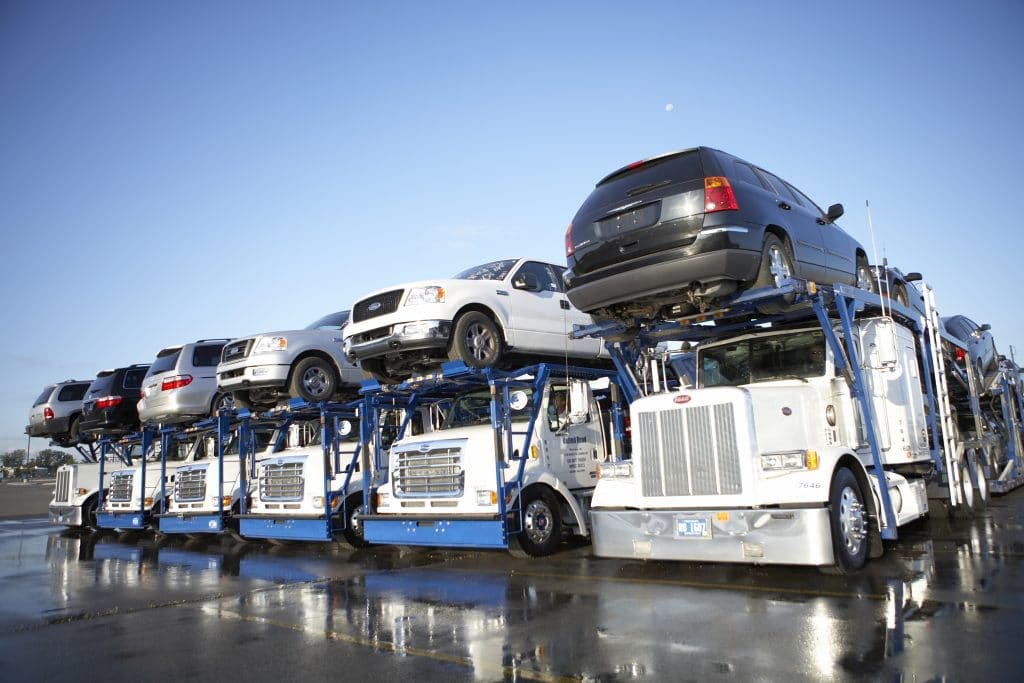Introduction: Shipping Vehicles To Canada
When it comes to shipping vehicles to Canada, potential restrictions and regulations can play a crucial role in determining the eligibility of a vehicle for importation. One significant factor that may impact the import process is the age of the vehicle. While Canada does not impose an outright ban on older vehicles, there are certain restrictions in place that aim to ensure safety and environmental standards are met.
The Canadian government has implemented specific guidelines regarding vehicle imports, with Transport Canada being responsible for overseeing compliance. As part of these regulations, vehicles must meet Canadian Motor Vehicle Safety Standards (CMVSS) to ensure they adhere to safety requirements. Additionally, vehicles manufactured outside of North America may need to undergo modifications or inspections before they can be considered eligible for importation.
Age restrictions on vehicles vary depending on their origin and purpose. For instance, if you plan to import a car from the United States into Canada, it must be at least 25 years old to be exempt from certain requirements. However, if you wish to bring a non-Canadian model that is less than 15 years old into the country, it needs to comply with specific admissibility criteria set by Transport Canada.
Understanding the age-related restrictions and guidelines for shipping vehicles to Canada is essential before initiating any import process.
Understanding Importation Regulations In Canada
Importing a vehicle into Canada requires compliance with certain regulations, including restrictions on the age of the vehicle. While there are no specific restrictions on the age of vehicles for shipping to Canada, it is important to consider other factors that may affect importation.
The Canadian government has implemented stringent safety and environmental standards for imported vehicles. Any vehicle, regardless of its age, must meet these standards before being allowed entry into the country. These standards ensure that all imported vehicles are safe to operate on Canadian roads and do not pose a threat to the environment.
To ensure compliance with safety and environmental regulations, imported vehicles must undergo an inspection known as the Registrar of Imported Vehicles (RIV) program. This program evaluates various aspects of the vehicle, including its safety features and emissions control systems.
It is worth noting that older vehicles may require modifications or upgrades to meet these standards. Importers should be prepared to make any necessary modifications or repairs before importing their vehicle.
Additionally, it is essential to familiarize oneself with any provincial or territorial regulations regarding vehicle importation. Some provinces may have additional requirements or restrictions on importing older vehicles.
By understanding these importation regulations in Canada, individuals can navigate the process more smoothly and ensure compliance with all necessary requirements for importing a vehicle into the country.
Age Restrictions On Vehicle Imports
When it comes to shipping vehicles to Canada, there are certain age restrictions that must be taken into consideration. The Canadian government has implemented regulations regarding the importation of vehicles, which include limitations based on the age of the vehicle.
In general, vehicles that are over 15 years old can be imported into Canada without any major restrictions. These older vehicles are often considered classic or vintage cars and are exempt from many of the safety and emission standards that apply to newer models.
However, for vehicles that are less than 15 years old, there are stricter regulations in place. Such vehicles must meet specific safety and emission standards set by Transport Canada. These standards ensure that the imported vehicles meet Canadian road safety requirements and environmental regulations.
It is important to note that certain types of vehicles may have additional age restrictions or specific requirements based on their classification. For example, buses, motorcycles, and other specialty vehicles may have different rules compared to regular passenger cars.
Before importing a vehicle into Canada, it is crucial to thoroughly research and understand the age restrictions imposed by Transport Canada. Compliance with these regulations will ensure a smooth importation process while maintaining compliance with Canadian laws and standards.
Determining The Minimum Age Requirement For Imported Vehicles
When it comes to shipping vehicles to Canada, it is important to understand the minimum age requirement for imported vehicles. The Canadian government has established regulations regarding the age of vehicles that can be brought into the country.
The minimum age requirement for imported vehicles is determined by the date of manufacture or first registration. According to Transport Canada, a vehicle must be at least 15 years old to be eligible for importation into Canada. This means that if a vehicle was manufactured or first registered less than 15 years ago, it cannot be shipped to Canada.
Furthermore, it is crucial to note that this age requirement applies to both new and used vehicles. Even if a vehicle is brand new but does not meet the minimum age requirement, it cannot be imported into Canada.
It is essential for individuals looking to ship their vehicles to Canada to verify its eligibility based on its date of manufacture or first registration. Failure to comply with these regulations may result in penalties or even refusal of entry by Canadian customs authorities.
Overall, understanding and adhering to the minimum age requirement for imported vehicles ensures a smooth and hassle-free shipping process when bringing a vehicle into Canada.
Exceptions To The Age Restrictions For Vehicle Imports
While there are certain age restrictions in place for importing vehicles into Canada, there are a few exceptions that allow vehicles outside the prescribed age limit to be shipped. One such exception is for antique or classic cars. These vehicles, typically considered to be over 25 years old, can be imported regardless of their age.
Another exception applies to vehicles that have undergone substantial modifications or restorations. If a vehicle has been extensively modified or restored, it may qualify for import even if it does not meet the age requirements. However, it is important to note that these modifications must comply with Canadian safety and environmental standards.
Furthermore, temporary imports are exempt from age restrictions as well. If you plan to bring a vehicle into Canada temporarily, such as for tourism or business purposes, you can do so without adhering to the age limitations.
It is worth mentioning that while these exceptions exist, they still require compliance with other import regulations and procedures. Importers must ensure that their vehicles meet all necessary safety and environmental standards before shipping them to Canada. Additionally, applicable taxes and duties may still apply regardless of any exceptions granted based on the age of the vehicle.
Compliance With Safety And Emissions Standards
When shipping a vehicle to Canada, it is important to ensure that the vehicle complies with the country’s safety and emissions standards. These standards are put in place to maintain road safety and protect the environment. While there are no specific restrictions on the age of the vehicle for shipping to Canada, older vehicles may face more scrutiny during inspection.
To comply with safety standards, vehicles must meet certain requirements related to their design, construction, and equipment. This includes features such as seatbelts, airbags, headlights, tires, brakes, and more. Additionally, vehicles must also meet emissions standards set by Environment Canada to reduce pollution levels.
It is worth noting that older vehicles may have a harder time meeting these standards due to advancements in technology and stricter regulations over time. As a result, individuals shipping older vehicles may need to make modifications or repairs before importing them into Canada.
To ensure compliance with safety and emissions standards when shipping a vehicle to Canada, it is advisable to consult with a qualified customs broker or transportation specialist who can provide guidance on any necessary modifications or inspections that may be required for your specific vehicle.
The Process Of Importing An Older Vehicle To Canada
Importing an older vehicle to Canada involves a specific process that must be followed in order to comply with the country’s regulations. One of the key considerations when importing a vehicle is the age restriction imposed by Canadian authorities. Canada allows the importation of vehicles that are at least 15 years old, counting from the date of manufacture. This means that vehicles manufactured more than 15 years ago can be brought into Canada without any age-related restrictions.
However, it is important to note that certain provinces may have additional regulations or restrictions on older vehicles, so it is advisable to check with the specific provincial transportation authority before initiating the import process. To import an older vehicle into Canada, several steps must be followed. Firstly, it is necessary to ensure that all required documents are in order, including proof of ownership and a valid title for the vehicle.
Additionally, a thorough inspection of the vehicle may be required to ensure compliance with Canadian safety and environmental standards. Once all documentation and inspections have been completed successfully, it is necessary to pay any applicable duties and taxes associated with importing the vehicle. These fees can vary depending on factors such as the age and value of the vehicle.
Additional Costs And Considerations For Older Vehicle Imports
When it comes to shipping vehicles to Canada, there are certain restrictions and considerations that apply to older vehicles. Importing an older vehicle may incur additional costs and require specific documentation. Here are some important factors to keep in mind:
1. Age Restrictions: The age of the vehicle plays a crucial role in determining its eligibility for importation into Canada. Generally, vehicles that are 15 years or older are more likely to face fewer restrictions compared to newer models. 2. Emission Standards: Older vehicles often do not meet current Canadian emission standards, which could lead to additional expenses. In such cases, modifications or upgrades might be necessary before the vehicle can be imported.
3. Safety Regulations: Importing an older vehicle may require compliance with Canadian safety regulations. Certain safety features such as airbags, seat belts, and anti-lock braking systems might need to be installed or upgraded according to Canadian standards. 4. Duty and Taxes: Importing an older vehicle may attract higher duty rates and taxes compared to newer models. The duty rate is determined based on factors such as the age of the vehicle, its value, and country of origin.
5. Inspection Requirements: Older vehicles might undergo a thorough inspection upon arrival in Canada to ensure they meet safety and environmental standards.
Benefits Of Importing A Newer Vehicle To Canada
Importing a newer vehicle to Canada offers several advantages over shipping an older vehicle. Firstly, newer vehicles are typically more fuel-efficient, which can result in significant savings on fuel costs in the long run. With rising fuel prices and growing environmental concerns, owning a vehicle that consumes less fuel is not only beneficial for your wallet but also for the planet.
Secondly, newer vehicles often come equipped with advanced safety features that older models may lack. These safety features include electronic stability control, adaptive cruise control, lane departure warning systems, and collision mitigation systems. Importing a newer vehicle with these technologies can enhance your driving experience and provide added protection for you and your passengers. Moreover, newer vehicles tend to have lower maintenance costs compared to older models.
They are less likely to experience major mechanical failures or require frequent repairs. This translates into reduced expenses on repairs and spare parts, allowing you to enjoy hassle-free ownership. Lastly, importing a newer vehicle may increase its resale value in the Canadian market. As Canadians prioritize safety and environmental considerations when purchasing used vehicles, having a recent model with modern features can make it more appealing to potential buyers if you decide to sell it in the future.
Conclusion: Navigating Age Restrictions When Shipping Vehicles To Canada
When shipping vehicles to Canada, it is essential to be aware of the age restrictions imposed by the Canadian government. These restrictions aim to ensure that imported vehicles meet safety and environmental standards, ultimately safeguarding Canadian roads and the environment.
While there are no specific age limits for importing vehicles into Canada, certain regulations must be met. For instance, all imported vehicles must conform to Canadian Motor Vehicle Safety Standards (CMVSS) and pass a thorough inspection conducted by the Registrar of Imported Vehicles (RIV). These measures help ensure that only safe and roadworthy vehicles are allowed on Canadian roads.
It is important to note that older vehicles may require modifications or alterations in order to comply with CMVSS. This can include adding features such as daytime running lights or upgrading safety systems. These modifications can add additional costs and time to the importing process.
To navigate age restrictions effectively, it is advisable to consult with a reputable customs broker or shipping agent who specializes in vehicle imports. They can provide valuable guidance on the necessary steps, regulations, and potential costs associated with shipping an older vehicle into Canada.
By understanding and adhering to these age restrictions, individuals can successfully import their vehicles into Canada while ensuring compliance with local safety standards.








